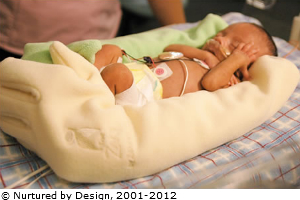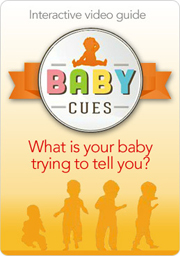
Photo credit: Beverly Demafiles Photography
Cues are How Your Baby Communicates
Cues are the signals your baby uses to show what they are feeling and how they are coping with the world around them. Babies can show this both through their behavior and through changes in their physiological state.
Your Baby’s Sensory World
If your baby was born early or is healing, they have special sensory needs. Preterm babies aren’t just smaller versions of full-term infants. They don’t just need to feed and grow. They need to mature. Their brains and nervous systems still need to undergo dramatic changes and reorganization. For example, at 35 weeks a baby’s brain is only 2/3 the size it will be at 40 weeks. If a baby is born early, their brain still needs to do all the growing and maturing it would have done inside the womb, but now it has to do it in the more challenging environment of the NICU.
Understanding Your Baby’s Language
Because your baby’s sensory world is still chaotic and confusing to them, they have to communicate using their most basic language – their physiological states.
-
Your Baby’s State Your baby will communicate how they are feeling by changes in their breathing, heartbeat and blood pressure. The monitors attached to your baby will help you keep track of these episodes of apnea and bradycardia (A’s and B’s). But you can also look at your baby’s skin color. Babies who are in distress may change colors. Sometimes they get “dusky” and bluish. Other times they might turn pale or even bright red.
- How Your Baby Moves Along with watching their color, you can also look at your baby’s movements and muscle tone. Immature and upset babies have jerky, disorganized movements and low muscle tone (they are hypotonic or “floppy”). As they mature, their color will be more consistent and their movements will be more organized and controlled. See a resource from Pathways.org that shows pictures of typical vs. atypical development (0-3 months).
♥ Babies don’t always behave the way they’re expected to. As your baby matures their states and movements will be more stable and organized, but they will still look different from other babies’. You will need to get to know your baby’s unique cues. Watch this wonderful video series from Raising Children Network of Australia.
When is It Too Much?
When babies are feeling distressed and overstimulated, they have very few ways to cope. You can watch for signs of over-stimulation and find ways to help them recover. Remember, when they do these things, they are trying to protect themselves. It is how they are able to adapt.
- Why Babies Get Overstimulated Babies are used to the dark, warm, protective environment of the womb. It is the ideal place for them to grow and for their brains to mature. When they are born early they aren’t ready for all the stimulation they will be getting. Read Understanding Preterm Infant Behavior in the NICU.

© iStockphoto.com/Juan Herrera
- How to Minimize the Stress Babies do better if they only have to deal with one or two things at a time. If they have to use all their senses at once, they can get overwhelmed. You can help by introducing new sensory experiences slowly and adding one thing at a time. Watch for what your baby enjoys. Be willing to try different things. For example, some NICU babies like rocking and baby massage while other babies won’t like rocking or stroking until they are older. It’s more than they can handle. So it is important not to do these things until they show signs that they are ready. Until they are, you can use gentle “resting hands” to cradle their body or lay your hands near them to comfort them. Read more about infant massage in the NICU.
When Are They Ready?
It takes time and patience, but soon your baby will be able to interact and communicate with you. You will know they have matured enough to do this when they are able to have quiet states of arousal (stimulation) with fewer periods of apnea and bradycardia. You will know they have matured enough when:
 They are Stable You will be able to start skin-to-skin care (kangaroo care) soon after your baby is born. Kangaroo care has been shown to help babies regulate their breathing, heart rate, and temperature (World Health Organization. 1993. Kangaroo mother care: a practical guide.) Ask the NICU staff to help you begin skin-to-skin care right away.
They are Stable You will be able to start skin-to-skin care (kangaroo care) soon after your baby is born. Kangaroo care has been shown to help babies regulate their breathing, heart rate, and temperature (World Health Organization. 1993. Kangaroo mother care: a practical guide.) Ask the NICU staff to help you begin skin-to-skin care right away.- They are Alert Your baby will start to have longer and longer periods where they make eye contact and are attentive. This is a signal that they are ready to start exploring their world.
- Their Movements are Symmetrical Your baby’s movements will seem more smooth and purposeful. They will start to develop enough strength and muscle tone to hold their body in a relaxed, flexed position where both sides of their body work together (are symmetrical and even).
Giving Your Baby What They Need
Learning your baby’s cues and how to respond to them will help you learn how to help your baby. You will be able to help them control their reactions to stimuli and adapt to their changing world. You can help your baby develop the important skills they need to:
- Comfort Themselves All babies need to learn how to calm themselves. By paying attention and supporting their behavior you can help your baby learn to soothe themselves. This might mean finding something like a fist or pacifier to suck on or finding a comfortable position to sleep on their backs.
- Self-Regulate By allowing your baby to seek out things when they’re ready and retreat when they’re overwhelmed, you are giving them important skills in “self-regulating.” Self-regulating means seeking stimulation when they are most receptive and shutting down when they need a break or time to process a new experience.
- Protect and Nourish Their Brain You and your baby will begin to explore their world together. Because you understand their cues, you will be able to help them explore in a way that challenges them and engages them, but doesn’t cause them too much stress. This is one of the greatest things you can do to support their healthy development.


